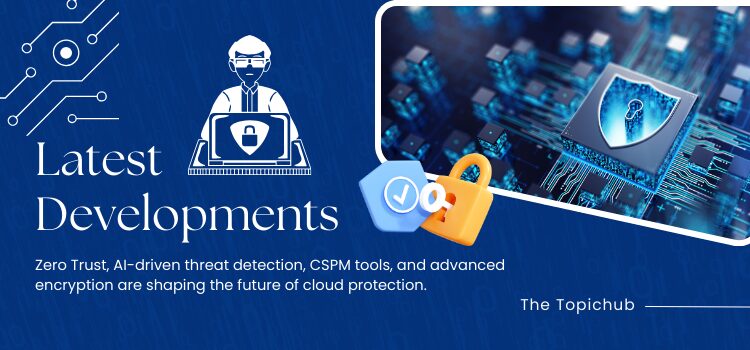Cloud Security
Cloud security is a set of policies, technologies, and controls designed to protect cloud computing environments, data, and applications from unauthorized access, use, disclosure, disruption, modification, or destruction. As more organizations move their data and applications to the cloud, ensuring the security of cloud environments has become increasingly important.
Vital Components of Cloud Security
- Data Encryption: Encrypting data both in transit and at rest to protect it from unauthorized access.
- Access Management: Controlling who has access to cloud resources and ensuring that users have the appropriate level of access.
- Network Security: Protecting cloud networks from unauthorized access and malicious activity.
- Compliance: Ensuring that cloud environments meet relevant regulatory and industry standards.

Cloud Security Challenges
- Data Breaches: Unauthorized access to sensitive data stored in the cloud.
- Misconfigured Cloud Resources: Cloud resources that are not properly configured, leaving them vulnerable to attack.
- Insider Threats: Authorized users who intentionally or unintentionally compromise cloud security.
- Compliance Challenges: Meeting regulatory requirements in cloud environments can be complex.
Quality Practices for Cloud Security
- Implement Strong Access Controls: Use multi-factor authentication and role-based access control to ensure that only authorized users have access to cloud resources.
- Monitor Cloud Environments: Continuously monitor cloud environments for security threats and vulnerabilities.
- Use Encryption: Encrypt data both in transit and at rest to protect it from unauthorized access.
- Regularly Update and Patch: Keep cloud resources up-to-date with the latest security patches and updates.
Cloud Security Solutions
- Cloud Security Platforms: Comprehensive platforms that provide a range of cloud security features, including threat detection, vulnerability management, and compliance monitoring.
- Cloud Access Security Brokers (CASBs): Solutions that provide visibility and control over cloud usage, as well as security features such as data encryption and threat detection.
- Cloud Workload Protection Platforms (CWPPs): Solutions that provide security and visibility for cloud workloads, including threat detection, vulnerability management, and compliance monitoring.
Advantageous of Cloud Security
- Improved Security: Cloud security solutions can provide improved security for cloud environments, data, and applications.
- Reduced Risk: Cloud security solutions can help reduce the risk of data breaches, cyber attacks, and other security threats.
- Increased Compliance: Cloud security solutions can help organizations meet regulatory requirements and industry standards.
- Better Visibility and Control: Cloud security solutions can provide better visibility and control over cloud environments, data, and applications.
ALSO READ: LinkedIn Advertising in 2025: Types, Benefits, CPC & Best Practices
Latest Developments
Cloud security is evolving rapidly, with several key trends emerging in 2025. Here are some of the latest developments:
- Zero Trust Architecture: This approach assumes that every entity is a potential threat and verifies each request for access based on user identity, device, and location. Zero Trust Architecture is becoming increasingly important due to the rise of remote work and cloud-based services.
- AI-Driven Threat Detection: Artificial Intelligence (AI) and Machine Learning (ML) are being used to detect and respond to security threats in real-time. AI-powered tools can analyze vast amounts of data to identify anomalies and potential threats.
- Enhanced Data Encryption: Advanced encryption techniques, such as homomorphic encryption and quantum-resistant encryption, are being developed to protect sensitive data in the cloud.
- Cloud Security Posture Management (CSPM): CSPM tools help organizations identify and remediate potential security risks in their cloud environments.
- DevSecOps Integration: Integrating security practices into the DevOps workflow ensures that security is considered at every stage of software development.
- Identity and Access Management (IAM): IAM systems are incorporating advanced features like adaptive authentication, biometric authentication, and role-based access control to enhance security and streamline access control processes.
These trends highlight the importance of proactive and adaptive security measures in protecting cloud environments from evolving threats

The Topic Hub will keep you informed!
For breaking news and perceptive analysis on a variety of subjects, we are your go-to source. By providing timely, reliable, and relatable news, we hope to keep you updated and involved with the most recent events. With Tech News, Latest Tech News, Government updates, Latest Government updates, Latest Business news, Latest Education news, Technology news, and Latest Technology news, we have you covered whether you’re searching for in-depth coverage or quick updates. Consider us your one-stop shop for anything news related!
Final Words
Cloud security is a critical aspect of cloud computing, and organizations must take steps to ensure the security of their cloud environments. By implementing strong access controls, monitoring cloud environments, using encryption, and regularly updating and patching cloud resources, organizations can reduce the risk of security threats and protect their data and applications in the cloud.
GET LATEST EDUCATION NEWS @ THE TOPIC HUB – https://thetopichub.com/
ALSO READ: ERP Software in 2025: Key Features, Benefits, Types & Best Practices
LATEST BLOG: TikTok Advertising in 2025: Ad Types, Benefits, Best Practices & ROI
